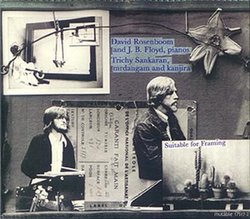| All Artists: J.B. Floyd, David Rosenboom, Trichy Sankaran Title: Suitable for Framing Members Wishing: 2 Total Copies: 0 Label: Mutable Music Original Release Date: 10/30/2004 Release Date: 10/30/2004 Genre: Jazz Style: Number of Discs: 1 SwapaCD Credits: 1 UPC: 801021751724 |
Search - J.B. Floyd, David Rosenboom, Trichy Sankaran :: Suitable for Framing
 | J.B. Floyd, David Rosenboom, Trichy Sankaran Suitable for Framing Genre: Jazz
On April 19th, 1975, at Northern Illinois University, three musicians met in a milestone event from which emerged a unique, improvising trio with two pianos and South Indian percussion. Fortunately, it was recorded and exc... more » |
Larger Image |
CD Details
Synopsis
Album Description
On April 19th, 1975, at Northern Illinois University, three musicians met in a milestone event from which emerged a unique, improvising trio with two pianos and South Indian percussion. Fortunately, it was recorded and excerpts released on a long out of print LP. This CD recaptures the essential essence of the entire evening of musical discovery with previously unreleased music recovered from digitally reprocessed tapes recently discovered in diverse states of preservation. Rosenboom and Floyd, formed a piano duo in the early 1970?s from which emerged a unique style of structured improvisation. They employed a wide range of musical tools, including techniques for implementing forms that evolve gradually in performance time, but invoked them spontaneously in improvisation, rather than through pre-composition. All the music arose uniquely in each musical moment. In 19IV75, some material was also drawn from the first and second movements of Rosenboom?s, The Seduction of Sapientia, and the second movement of Patterns for London. Composed in 1972 for London?s International Carnival of Experimental Sound, each of Patterns for London?s three movements is a cyclical form with no beginning or end. Movement I is comprised of a circular progression of tonal modules, each defined by a set of ostinato chords and modal scales, all containing the common tone, A. These are expanded through improvisation. This is a virtuosic solo mixing Sankaran?s compositions with improvisation in the eight-beat cycle, Adi tala. It progresses through introductory and middle stages to modulating to six pulses per beat, called tisra gati, and finally, to an exciting fast pharan section. In the middle, a call and response idea is articulated with only one mrdangam, but sounds as if there are more. The entire solo is improvised in a traditional format in line with the spirit of the two-piano performances. Appropriately, Rosenboom joins in at the end with an accompanying pattern, like a return to the "head" in jazz. Is Art Is is an infinite form, cyclical and open, without finite time-space boundaries, with equality of drone and impulse, interfusion of universal and particular, exploring open time-spaces and gradual processes. Composed originally in 1974 for Floyd?s group, Electric Stereopticon, it is constructed much like a jazz tune with a head in twelve-beats, a middle section with patterns played in various phase relationships over a seven-beat ostinato, and a return to the "head" with overlapping themes. The rhythmic modules relate well to the language of Indian drumming, and Sankaran helped expand the form. On one surviving tape, we discovered additional playing in which the trio improvises on material from drawn from the third movement of Rosenboom?s Patterns for London and parts of his 1964 gradual process piece, Continental Divide. Sankaran played kanjira, a South Indian tambourine constructed with a wooden ring, one set of metal jingles, and a stretched membrane of lizard skin. This may have been recorded prior to the concert during a sound check. It is presented as a bonus snapshot of this trio?s inventive musical spirit. (Suitably, perhaps, the reel ran out before the music ended, so we?ve made the music fly off into a suitable space.)

 Track Listings (5) - Disc #1
Track Listings (5) - Disc #1